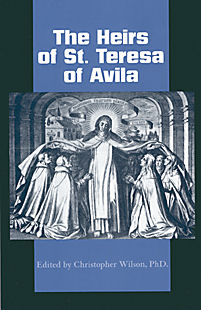
|
Posted January 12, 2007
Book: The Heirs of St. Teresa of Avila Edited by Christopher Wilson ICS Publications. Washington, DC. 2006. Pp. 140 An Excerpt from the Jacket:
The essays were originally presented at the 2004 symposium “The Heirs of St. Teresa” at Georgetown University. That year marked the 400th anniversary of a pivotal moment in Discalced Carmelite history: the arrival in France of a group of six nuns, some of Teresa’s most favored protegees, including Ana de Jesus and Ana de San Bartolome, who had traveled from Spain to inaugurate the order’s first French convent. Motivated by devotion to their Founding Mother, amidst successes and setbacks, these and other of Teresa’s heirs strove to carry out her will with a resolute determination and to extend her reputation for sanctity through the world. An Excerpt from the book: Two Appreciations of St. Joseph In the Life, chapter 6, and in the works of Ribera and Gracian, the various roles that St. Joseph fulfilled in Teresa’s life and experience are enumerated: the heavenly physician who healed her from paralysis; spiritual father (an unprecedented advocation for the saint in Christian history) who “came to her rescue in better ways than she knew how to ask for”.; an all-powerful intercessor who “helps in all our needs”; a celestial benefactor who repays souls who recommend themselves to him with advancement in virtue: a teacher of prayer who assisted Teresa in her longtime struggle with prayer: a protector on her many journeys. Filled with “the desire to persuade all to be devoted to St. Joseph.” Teresa extended her privileged relationship with St. Joseph to the Teresian Carmel by making him, in accord with a vision she received from the Lord, the guardian of her foundations, thus underscoring St. Joseph’s role as father not only in her life, but also, henceforth, in the life of the Teresian Carmel. The one role that encompasses all St. Joseph’s other roles is that he is the most powerful intercessor who helps in every need, whether spiritual or temporal, making him a universal saint. The theological foundation for this extraordinary unfailing intercessory power is St. Joseph’s singular relationship to Jesus. Teresa writes: For with other saints it seems the Lord has given them grace to be help in one need, whereas with this glorious saint I have experience that he helps in all our needs and that the Lord wants us to understand that just as He was subject ot St. Joseph on earth – for since bearing the title of father, being the Lord’s tutor, Joseph could give the Child command — so in heaven God does whatever he commands. (Life, 6,6). Table of Contents: 1. Maria de San Jose (Salazar): Saint Teresa’s “Difficult” Daughter 2. Paul the enhancer: St. Teresa’s vow of obedience to Gracian 3. Heeding the ‘Madre’ Ana de San Agustin and the voice of Santa Teresa 4. Blessed Anne of St. Bartholomew 5. Taking Teresian authority to the front lines: Ana de San Bartolome and Ana de Jesus in art of the Spanish Netherlands 6. Touched by Teresa: readers and their responses, 1588-1750 7. St. Joseph in the spirituality of Teresa of Avila and of Francis de Sales: convergences and divergences |
|
